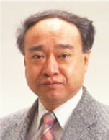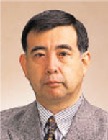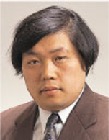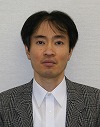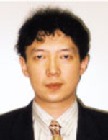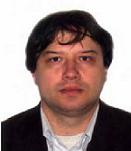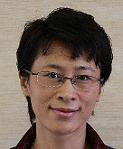The scope of activities of Mathematics and Physics Group spans all aspects of research
and education in the fields of mathematical sciences. Our current researches in the field
of mathematics are devoted to various subjects and problems arising in both pure and
applied mathematics: non-associative algebras, neural networks, unimodality problems,
algebraic combinatorics, spherical functions, homotopy theory, and arithmetic theory.
In the fields of physics, theoretical research is performed in many-body theories, nuclear
physics, quantum gravity and quantum mechanics of constrain system.
There has been also a project to develop educational textbooks and software for mechanics,
electromagnetism and quantum mechanics. The research areas assigned to each
co-researcher are as follows:
Prof. H. Sagawa
|
sstudies the physics of the many-body system of including
atomic nuclei, microclusters and quantum information
theory.
|
Prof. N. Kamiya
|
studies the theory of non-associative algebras and a
structure theory of algebras from triple systems
|
Prof. T. Watanabe
|
generalizes the unimodality problems of 1-dimensional
infinitely divisible distributions to multi-dimensional
cases in the use of analytical methods
|
Prof. K. Shimizu
|
advances the traditional quantum theory and creates
the geometrical theory of quantum gravity
|
Prof. K. Asai
|
researches combinatorial identities for generalized
Young tableaux, and also, several generating functions
arising from algebraic combinatorics
|
Prof. T. Watanabe
|
generalizes the unimodality problems of 1-dimensional
infinitely divisible distributions to multi-dimensional
cases in the use of analytical methods
|
Prof. M. Honma
|
researches the microscopic structures and dynamics
of the nuclei by the algebraic methods and geometrical
models performing the quantitative analysis by
the large-scale numeric calculations
|
Prof. H. Kihara
|
studies homotopy theory and its applications to various
areas of mathematics
|
Prof. T. Maeda
|
studies arithmetic of elliptic curves and modular forms
and their applications
|
Prof. S. Watanabe
|
studies geometrical interpretations of generating functions
for spherical functions on homogeneous spaces
|
Prof. A. Fujitsu
|
studies the numerical superstring and quantum gravity
|
Prof. M. Yamagami
|
studies the physics of atomic nuclei under the extreme
condition based on the density functional theory
|
Refereed Journal Papers
[k-asai-01:2009]
|
Kazuto Asai. Homogeneous partial differential equations for superpositions
of indeterminate functions of several variables. Izvestiya Rossiiskoi
Akademii Nauk. Seriya Matematicheskaya, Russian Academy of Sciences,
Steklov Mathematical Institute Izvestiya: Mathematics (English translation),
London Mathematical Society, 73(1):31–48; 31–46 (English translation),
2009.
|
|
Abstract: We determine essentially all partial differential equations satisfied by
superpositions of tree type and of a further special type. These equations represent
necessary and sufficient conditions for an analytic function to be locally expressible
as an analytic superposition of the type indicated. The representability of a real
analytic function by a superposition of this type is independent of whether that
superposition involves real-analytic functions or C -functions, where the constant
is determined by the structure of the superposition. We also prove that the
function u defined by un = xua+yub+zuc+1 is generally non-representable in any
real (resp. complex) domain as f(g(x; y); h(y; z)) with twice differentiable f and
differentiable g, h (resp. analytic f, g, h). Keywords: superposition, essentially all
PDEs, rooted trees, Hilbert’s 13th problem, minors. MSC: 12H05, 32A05, 32A10,
32A38, 35E15, 35E20, 35N05
|
[kamiya-01:2009]
|
N. Kamiya and S. Hirabayashi. A generalization of Pythagorian numbers
from the viewpoint of nonassociative algebras. Algebras, groups and
geometries, 26:45–52, 2009.
|
|
We discuss a generalization of Pythagorean numbers. In particular, the octonionic
product can be showned to be useful when expressed in terms of the bilinear
Hurwitz product.
|
[kamiya-02:2009]
|
Noriaki Kamiya and Susumu Okubo. Representation of ( ; ;
) triple
systems. Linear and Multilinear algebras, Pages 617 - 643, 2009.
|
|
This article is to study certain triple systems, in particular, (+,+,-),and structurable
algebras.
|
<[kamiya-03:2009]br>
|
N. Kamiya, D. Mondoc, and S. Okubo. A structure theory of (-1,-1)
Freudenthal-Kantor triple systems. Bull.Aust.Math., 81(1):32 - 15, 2009.
|
|
This paper is to give a structure theory of triple systems. In particular,study
simplicity and associated Jordan triple systems.
|
[m-honma-01:2009]
|
D. Steppenbeck, A. N. Deacon, S. J. Freeman, R. V. F. Janssens,
S. Zhu, M. P. Carpenter, P. Chowdhury, M. Honma, T. Lauritsen, C. J.
Lister, D. Seweryniak a nd J. F. Smith, S. L. Tabor, and B. J. Varley.
High-spin structures in the neutron-rich isotopes 5760Mn. Phys. Rev. C,
81:014305/1–21, 2010.
|
|
Excited states in the neutron-rich isotopes 57−60Mn have been studied with fusionevaporation
reactions induced by 48Ca beams at 130 MeV on 13;14C targets. Level
schemes have been deduced reaching spins of ∼ 16¯h and ∼ 27=2¯h in the odd-odd
and odd-even isotopes, respectively. States with natural parity within an fp model
space are compared to the predictions of large-scale shell-model calculations using
the recently developed GXPF1A effective interaction. Quasirotational structures
are evident in all of the isotopes and are discussed in terms of the deformationdriving
potential of the g9=2 intruder orbital. It is apparent that an enlarged model
space, incorporating at least the 1g9=2 intruder state, is necessary to reproduce the
observed experimental systematics in a more satisfactory manner.
|
[m-honma-02:2009]
|
T. Suzuki, M. Honma, K. Higashiyama, T. Yoshida, T. Kajino,
T. Otsuka, H. Umeda, and K. Nomoto. Neutrino-induced reactions on
56Fe and 56Ni, and production of 55Mn in population III stars. Phys. Rev.
C, 79:061603(R)/1–4, 2009.
|
|
Neutrino-induced reactions on 56Fe and 56Ni are investigated based on a new shellmodel
Hamiltonian for pf shell. The calculated charged current reaction cross
section on 56Fe induced by decay-at-rest (DAR) neutrinos is shown to be consistent
with the observation. The Gamow-Teller strength in 56Ni is found to be
more spread compared to previous calculations and result in a considerably large
branching ratio for the proton knock-out channel. As a consequence of this, the
production yields of heavy elements such as 55Mn in population III stars are shown
to be enhanced for the new Hamiltonian
|
[m-honma-03:2009]
|
S. Zhu, R. V. F. Janssens, B. Fornal, S. J. Freeman, M. Honma,
R. Broda, M. P. Carpenter, A. N. Deacon, E. Jackson, B. P. Kay, T. Lauritsen,
C. J. Lister, P. F. Mantica, T. Otsuka, D. Seweryniak, J. F. Smith,
D. Steppenbeck, and X. Wang. High-lying, non-yrast shell structure in
52Ti. Phys. Rev. C, 80:024318/1–11, 2009.
|
|
Gamma rays from 52Ti have been studied with Gammasphere and the Fragment
Mass Analyzer using reactions induced by a 48Ca beam on a 9Be target. The data
have been used in combination with information from deep-inelastic reactions of
48Ca beams on a thick 238U target at an energy about 25% above the Coulomb
barrier. The 52Ti level scheme was expanded considerably, and the lifetimes of
some of the identified states were determined for the first time. The excitation of
two protons and two neutrons outside the 48Ca core provide new tests of effective
interactions in the full pf-shell model space. The positive-parity states in 52Ti were
compared to theoretical predictions obtained with the GXPF1A, FPD6, and KB3G
effective interactions. The comparisons favor, to a degree, the results computed
with the GXPF1A interaction.
|
[m-honma-04:2009]
|
Takaharu Otsuka, Toshio Suzuki, Michio Honma, Yutaka Utsuno,
Naofumi Tsunoda, Koshiroh Tsukiyama, and Morten Hjorth-Jensen. Novel
Features of Nuclear Forces and Shell Evolution in Exotic Nuclei. Phys. Rev.
Lett., 104:012501/1–4, 2010.
|
|
Novel simple properties of the monopole component of effective nucleon-nucleon
interactions are presented, leading to the so-called monopole-based universal interaction.
Shell structures are shown to change as functions of N and Z, consistent
with experiments. Some key cases of this shell evolution are discussed, clarifying
the effects of central and tensor forces. The validity of the present tensor force is
examined in terms of the low-momentum interaction Vlowk and the Qbox formalism.
|
[m-honma-05:2009]
|
M. Honma, T. Otsuka, T. Mizusaki, and M. Hjorth-Jensen. New
effective interaction for f5pg9-shell nuclei. Phys. Rev. C, 80:064323/1–36,
2009.
|
|
We present a new effective interaction for shell-model calculations in the model
space consisting of the single-particle orbits 1p3=2, 0f5=2, 1p1=2, and 0g9=2. Starting
with a realistic interaction based on the Bonn-C potential, 133 two-body matrix
elements and four single-particle energies are modified empirically so as to fit 400
experimental energy data out of 69 nuclei with mass numbers A=63∼96. The
systematics of binding energies, electromagnetic moments and transitions, and
low-lying energy levels are described. The soft Z=28 closed core is observed, in
contrast to the stable N=50 shell closure. The new interaction is applied to systematic
studies of three different chains of nuclei, Ge isotopes around N=40, N=Z
nuclei with A=64∼70, and N=49 odd-odd nuclei, focusing especially on the role
of the g9=2 orbit. The irregular behavior of the 0+
2 state in Ge isotopes is understood
as a result of detailed balance between the N=40 single-particle energy
gap and the collective effects. The development of the band structure in N=Z
nuclei is interpreted in terms of successive excitations of nucleons into the g9=2
orbit. The triaxial/
-soft structure in 64Ge and the prolate/oblate shape coexistence
in 68Se are predicted, showing a good correspondence with the experimental
data. The isomeric states in 66As and 70Br are obtained with the structure of an
aligned proton-neutron pair in the g9=2 orbit. Low-lying energy levels in N=49
odd-odd nuclei can be classified as proton-neutron pair multiplets, implying that
the obtained single-particle structure in this neutron-rich region appears to be
appropriate. These results demonstrate that, in spite of the modest model space,
the new interaction turns out to describe rather well properties related to the g9=2
orbit in various cases, including moderately deformed nuclei.
|
[m-honma-06:2009]
|
M. Sugawara, Y. Toh, M. Oshima, M. Koizumi, A. Kimura, A. Osa,
Y. Hatsukawa, H. Kusakari, J. Goto, M. Honma, M. Hasegawa, and
K. Kaneko. Medium-spin states in 70Ge and the role of the g9=2 orbital.
Phys. Rev. C, 81:024309/1–10, 2010.
|
|
Medium-spin states of 70Ge have been studied via the 60Ni(12C,2p
)70Ge reaction
at 45 MeV. The ground-state band and the second 0+ band have been extended to
the 12+ and 8+ states, respectively. Two negative-parity bands, one of which has
a coupled structure and the other has a decoupled structure, have been observed
additionally. Although the latter decoupled structure was known up to the (21−)
state from a previous experiment, the part of the level scheme up to the 15−
state has been largely modified by the present experiment. Backbendings observed
in the positive- and negative-parity yrast bands have been compared with those
of the neighboring even Ge isotopes. The experimental level structure has been
compared with the shell-model calculations in the model space (2p3=2, 1f5=2, 2p1=2,
1g9=2) employing two kinds of effective interactions, one of which is an extended
P+QQ interaction with monopole interactions and the other is developed from a
renormalized G matrix. Microscopic structures of the observed bands have been
discussed with the help of the shell-model calculations.
|
[sagawa-01:2009]
|
C.L. Bai, H.Q. Zhang, X.Z. Zhang, F.R.Xu, H. Sagawa, and G. Col`o.
Quenching of Gamow-Teller strength due to Tensor Correlations in 90Zr
and 208Pb. Phys. Rev. C, 79:041301(R)/pp.1–5, 2009.
|
|
We performed self-consistent HF+RPA calculations for charge exchange 1+ states
in 90Zr and 208Pb by using Skyrme interactions with tensor terms. We have employed
a parameter set in which the tensor terms are added to the SGII interaction.
It is pointed out that Gamow-Teller(GT) states can couple strongly with the spinquadrupole
(SQ) 1+ states in the high energy region above Ex=30 MeV due to
the tensor interactions. As the result of this coupling, more than 10% of the GT
strength is shifted to the energy region above 30 MeV, and the main GT peak
is moved 2 MeV downward. At the same time, the main SQ 1+ peak is moved
upward by more than 10 MeV due to the tensor correlations. Schematic separable
interactions are proposed to elucidate the quenching mechanism induced by the
tensor interaction on the GT state
|
[sagawa-02:2009]
|
K. Hagino, H. Sagawa, T. Nakamura, and T. Shimoura. Two-particle
Correlations in Continuum dipole excitations in Borromean nuclei. Phys.
Rev. C, 80:031301(R)pp.1–4, 2009.
|
|
We discuss the energy and angular distributions of two emitted neutrons from
the dipole excitation of typical weakly-bound Borromean nuclei, 11Li and 6He.We
use a three-body model with a density dependent contact interaction between the
valence neutrons. Our calculation indicates that the 2D energy distributions for the
emitted neutrons are considerably different between the two nuclei, although both
the nuclei show similar strong dineutron correlations in the ground state to each
other.This different behaviour of the energy distributions is primarily attributed to
the presence of s-wave virtual state in the residual neutron-core system 10Li, which
is absent in 5He. It is also pointed out that the angular distribution for 11Li in the
low energy region shows a clear manifestation of the strong dineutron correlation,
whereas the angular distribution for 6He exhibits a strong anticorrelation effect.
|
[sagawa-03:2009]
|
Li-Gang Cao, G. Col`o, P.F. Bortignon, H. Sagawa and L. Sciacchitano.
Effect of the Tensor Force on Multipole Response in Finite Nuclei. Phys.
Rev. C, 80:064304/pp. 1–8, 2009.
|
|
We present a thorough analysis of the effect of the tensor interaction on the multipole
response of magic nuclei, using the fully self-consistent Random Phase Approximation
(RPA) model with Skyrme interactions. The role of the tensor correlations
is dissentangled on the static mean-field and the residual particle-hole
(p-h) interaction, separately , for quadrupole (2+), hexadecupole (3−) and also
magnetic dipole resposes (1+). It is pointed out that the tensor force has a larger
effect on the magnetic dipole states than the natural parity ones 2+ and 3−, especially
in the mean field level. Perspectives for a better assessment of the tensor
force parameters are eventually discussed.
|
[sagawa-04:2009]
|
J. Margueron, S. Goriely, M. Grasso, S. Goriely, G. Col´o, and
H. Sagawa. Extended Skyrme Interaction: ground states of nuclei and
of nuclear matter. J. Phys. G, 36:125103/pp.1–14, 2009.
|
|
We study the effect of time-odd components of the Skyrme energy density functionals
on the ground state of finite nuclei and in nuclear matter. The spin-dependent
terms are shown to change the total binding energy of odd nuclei by only few
tenths of keV, while time-odd components of standard Skyrme interactions give
an effect that is larger by one order of magnitude. The HFB-17 mass formula based
on SKyrme interaction is adusted including the new spin-density dependent terms.
|
[sagawa-05:2009]
|
C.L. Bai, H. Sagawa, H.Q. Zhang, X.Z. Zhang, G. Col`o, and F.R. Xu.
Effect of Tensor Correlations on Gamow-Teller States in 90Zr and 208Pb.
Phys. Lett. B, 675:28–31, 2009.
|
|
The tensor terms of the Skyrme effective interaction are included in the selfconsistent
Hartree-Fock plus Random Phase Approximation (HF+RPA) model.
The Gamow-Teller (GT) strength function of 90Zr and 208Pb are calculated with
and without the tensor terms. The main peaks are moved downwards by about
2 MeV when including the tensor contribution. About 10% of the non-energy
weighted sum rule is shifted to the excitation energy region above 30 MeV by
the RPA tensor correlations. The contribution of the tensor terms to the energy
weighted sum rule is given analytically, and compared to the outcome of RPA. A
microscopic origin of the quenching of GT sum ruleis discussed in relation with
the coupling to giant spin-quadrupole excitations by the tensor interactions.
|
[sagawa-06:2009]
|
H.-J. Schulze, Myaing Thi Win, K. Hagino, and H. Sagawa. Hyperons
as a probe of nuclear deformation. Prog. Theor. Phys., 123:pp.569–580,
2010.
|
|
We study the change of nuclear deformation induced by the presence of one or two
lambda hyperons in light and medium-heavy nuclei, comparing Skyrme-Hartree-
Fock and relativistic mean field model predictions. The physical origin of the deformation
changes is discussed in terms of the lambda and nucleon mean field
potentials. We identify 30Si and 30S as candidates with possible large deformation
differences between the core nucleus and the hypernucleus.
|
[sagawa-07:2009]
|
Peter M¨oller, Ragnar Bengtsson, Hiroyuki Sagawa, and Takatoshi
Ichikawa. Global Calculations of Nuclear Shape Coexistence. Phys. Rev.
Lett., 103:212501/pp.1–4, 2009.
|
|
Nuclear shape isomers are well-known in the Kr and Pb regions. To establish how
prevalent shape isomers are across the nuclear chart we use a well-benchmarked
macroscopic-microscopic model to calculate potential-energy surfaces as functions
of spheroidal (Q2), hexadecapole (Q4), and axial-asymmetry (γ) shape coordinates
for 7206 nuclei from A = 31 to A = 290. We analyze these and identify the
deformation and energies of all minima deeper than 0.2 MeV. The results allow
us to identify nuclei in which shape isomers may be experimentally observed. We
find that the vast majority of nuclear shape isomers occur in the A = 80 region, A
= 100 region, and in a more extended region centered around 208Pb. We compare
our model to experimental data for a sequence of Kr data and find encouraging
agreement, which motivated our global calculation. Our main result is given in a
contour diagram versus N and Z, which for each nucleus shows the number of minima
obtained. The results reveal one fairly unexplored region of shape isomerism,
which is experimentally accessible, namely the region north-east of 208 Pb82, that
is Z > 82andN > 126.
|
[sagawa-08:2009]
|
W.H. Long, J. Meng, T. Nakatsukasa, H. Nakada, and H. Sagawa.
Z=64 shell shell closure and single-particle states. Phys. Lett. B (2009),
680:pp. 428–431, 2009.
|
|
Evolutions of Single-particle energies and Z = 64 sub-shell along the isotonic chain
of N = 82 are investigated in the density dependent relativistic Hartree-Fock
(DDRHF) theory in comparison with other commonly used mean field models
such as Skyrme HF, Gogny HF and density dependent relativistic Hartree model
(DDRMF).It is pointed out that DDRHF reproduces well characteristic features of
experi mental Z dependence of both spin orbital and pseudo-spin orbital splittings
around the subshell clo sure Z = 64. Exchange terms of the isoscalar and !
couplings play dominant r oles in the enhancements of the spin-orbit splitting of
2d states, which is the key ingredient to give the Z = 64 sub-shell closure properly.
On the other hand, the and tensor contributions for the spin-orbit splitting
cancel each other and the net effect becomes rather small. The enhancement of
the sub-shell gaps towards Z = 64 is studied by the DDRHF, for which the local
terms of the sc alar and vector meson couplings are found to be important.
|
[sagawa-09:2009]
|
C.A. Bertulani, Hongfeng L¨u, and H. Sagawa. Odd-even mass
difference and isospin dependent pairing interaction. Phys. Rev. C,
80:027303/pp.1–4, 2009.
|
|
The neutron and proton odd-even mass differences are studied with Hartree-
Fock+BCS (HFBCS) calculations with Skyrme interactions and an isospin dependent
contact pairing interaction, which is recently derived from a microscopic
nucleon-nucleon interaction. To this end, we perform HFBCS calculations for even
and odd semi-magic Tin and Lead isotopes together with even and odd Z isotones
with N= 50 and 82. The filling approximation is applied to the last unoccupied
particle in odd nuclei. Comparisons with the experimental data show a clear manifestation
of the isospin dependent pairing correlations in both proton and neutron
pairing gaps.
|
[sagawa-10:2009]
|
J. Margueron and H. Sagawa. Extended Skyrme interaction: spin
fluctuations in dense matter. J. Phys. G, 36:125102/pp.1–11, 2009.
|
|
Most of the Skyrme interactions are known to predict spin or isospin instabilities
beyond the saturation density of nuclear matter which contradict predictions based
on realistic interactions. A modification of the standard Skyrme interaction is
proposed so that the ferromagnetic instability is removed. The new terms are
density dependent and modify only the spin p-h interaction in the case of spinsaturated
system. Consequences for the nuclear response function and neutrino
mean free path are shown. The overall effect of the RPA correlations makes dense
matter more transparent for neutrino propagation by a factor of 2 to 10 depending
of the density.
|
[sigeru-w-01:2009]
|
S. Watanabe. Symmetry in Generating Functions. Symmetry,
2(1):346–365, March 2010.
|
|
Generating functions play important roles in theory of orthogonal polynomials.
In particular, it is important to consider generating functions that have symmetry.
This paper is a survey on generating functions that define unitary operators.
First, classical generating functions that define unitary operators are discussed.
Next, group theoretical approach to generating functions that have unitarity are
discussed.
|
[t-watanb-01:2009]
|
T. Watanabe and K. Yamamuro. Ratio of The Tail of An Infinitely
Divisible Distribution on The Line to That of Its Levy Measure. Electronic
Journal of Probability, 15:44–74, 2010.
|
|
A necessary and sufficient condition for the tail of an infinitely divisible distribution
on the real line to be estimated by the tail of its Levy measure is found. The lower
limit and the upper limit of the ratio of the right tail of an infinitely divisible
distribution to the right tail ofits Levy measure are estimated from above and below
by reviving Teugels’s classical method. The exponential class and the dominated
varying class are studied in detail.
|
[yamagami-01:2009]
|
Y. R. Shimizu M. Yamagami and T. Nakatsukasa. Optimal pair
density functional for the description of nuclei with large neutron excess.
Phys. Rev. C, 80:064301 /1–10, 2009.
|
|
Toward a universal description of pairing properties in nuclei far from stability, we
extend the energy density functional by enriching the isovector density dependence
in the particle-particle channel (pair density functional, pair-DF). We emphasize
the necessity of both the linear and quadratic isovector density terms. The parameters
are optimized by the Hartree-Fock-Bogoliubov calculation for 156 nuclei of
mass number A=118 to 196 and asymmetry parameter (N-Z)/A¡0.25. We clarify
that the pair-DF should include the isovector density dependence in order to take
into account in a consistent manner the effect of the isoscalar and isovector effective
masses in the particle-hole channel. The different Skyrme forces can give the
small difference in the pairing gaps toward the neutron drip line if the optimal
pair-DF, consistent with the particle-hole channel, is employed.
|
[yamagami-02:2009]
|
M. Yamagami H. Nakada, K. Mizuyama and M. Matsuo. RPA
calculations with Gaussian expansion method. Nucl. Phys. A, 828:283–305,
2009.
|
|
The Gaussian expansion method (GEM) is applied to calculations of the nuclear
excitations in the random-phase approximation (RPA). We adopt the massindependent
basis-set that is successful in the mean-field calculations. The RPA
results obtained by the GEM are compared with those obtained by several other
available methods in Ca isotopes, by using a density-dependent contact interaction
along with the WoodsSaxon single-particle states. It is confirmed that energies,
transition strengths and widths of their distribution are described by the GEM
with good precision, for the 1-, 2+ and 3 - collective states. The GEM is then
applied to the self-consistent RPA calculations with the finite-range Gogny D1S
interaction. The spurious center-of-mass motion is well separated from the physical
states in the E1 response, and the energy-weighted sum rules for the isoscalar transitions
are fulfilled reasonably well. Properties of low-energy transitions in 60Ca
are investigated in some detail.
|
[yamagami-03:2009]
|
T. Nakatsukasa M. Yamagami, Y. R. Shimizu. Density functional
for description of novel pairing properties in nuclei far from -stability.
RIKEN Accel. Prog. Rep., 42:47, 2009.
|
|
Aiming for a universal description of pairing correlations in nuclei far from -
stability, we extend the energy density functional (DF) by enriching the density
dependence of the isoscalar and isovector couplings in the particle-particle channel
(pair-DF). We emphasize the necessity of the quadratic isovector density term in
addition to the linear terms for description of pairing properties in nuclei with
large neutron excess.
|
[yamagami-04:2009]
|
M. Yamagami S. Mizutori H. Ogasawara, K. Yoshida and K. Matsuyanagi.
Rotational Frequency Dependence of Octupole Vibrations on
Superdeformed States in 40Ca. Prog. Theor. Phys., 121:357–374, 2009.
|
|
By means of the random phase approximation (RPA) calculation based on cranked
deformed Woods-Saxon potential, we investigate how rotational motion affects the
properties of octupole vibrations built on superdeformed states in 40Ca. A major
structure change of the superdeformed yrast states toward a reflection-asymmetric
shape is suggested to take place in the region of angular momentum a little higher
than the observed maximum value 16¯h, owing to a cooperative effect of octupole
vibrational correlation and the rotation-aligned particle-hole excitations from the
f7=2 to the g9=2 shell.
|
Unrefereed Papers
[kihara-01:2009]
|
Hiroshi Kihara. Spaces of homomorphisms of Lie groups and Lie algebras.
In Katsuhiko Kuribayashi Takeshi Torii, editor, Proceedings of Algebraic
and Geometric Models of Spaces and Their Perspectives 2009, pages pp. 96–104,
2009.
|
Books
[sagawa-11:2009]
|
H. Sagawa and N Yohida. Quantum Information Theory (second edition).
Springer-Japan, 2009.
|
Chapters in Book
[sagawa-12:2009]
|
H. Sagawa. Recent progress on quantum many-body systems, pages pp.
122 – 130. Science Cooperation( in Japan), 1 2010.
|
Grants
[sagawa-13:2009]
|
H. Sagawa. A study of asymmetric nuclear matter and nuclei with the
paring correlations and energy density functionals., 2009.
JSPS research grant
|
Academic Activities
[sigeru-w-02:2009]
|
S. Watanabe, 2009-2010.
Reviewer : Mathematical Reviews published by the American Mathematical Society
|
[t-maeda-01:2009]
|
Takao Maeda, March 2010.
At the Information Processing Society of Japan 50th Anniversary 72nd National Convention
of IPSJ, presented “Introduction of PC Koshien Activities” and participated
in panel discussion on “To foster IT talents through programming contests.”
|
Ph.D,Master and Graduation Theses
[m-honma-07:2009]
|
Shogo Yoshida. Graduation Thesis: Computer Simulations for
Chemical Oscillations, University of Aizu, 2010.
Thesis Advisor: M. Honma
|
[sagawa-14:2009]
|
Yuuta Ninomiya. Graduation Thesis: Experimental Violation of Bell
Inequality using Hybrid Entangles pairs., School of Computer Science and Engineering,
2009.
Thesis Advisor: H. Sagawa
|
[sigeru-w-03:2009]
|
Tomomi Uchiyama. Graduation Thesis: History of Calculus as a
Teaching Approach, University of Aizu, 2009.
Thesis Adviser: S. Watanabe
|
[sigeru-w-04:2009]
|
Junichi Yamauchi. Graduation Thesis: Development of teaching
materials that use history of mathematics, University of Aizu, 2009.
Thesis Adviser: S. Watanabe
|
[sigeru-w-05:2009]
|
Kayoko Shinjo. Graduation Thesis: New Functions Defined by Generating
Functions Associated with Hermite Polynomials, University of Aizu,
2009.
Thesis Adviser: S. Watanabe
|
[sigeru-w-06:2009]
|
Masahiro Suwa. Graduation Thesis: A History of Mathematics:
Implications for Mathematics Education in Junior High School, University of
Aizu, 2009.
Thesis Adviser: S. Watanabe
|
[sigeru-w-07:2009]
|
Misaki Nemoto. Graduation Thesis: New Functions Associated with
Hermite Polynomials, University of Aizu, 2009.
Thesis Adviser: S. Watanabe
|

2011 THE UNIVERSITY OF AIZU ALL RIGHTS RESERVED
|
